MANAGUA, Nicaragua (AP) - Indian chiefs and dancing red and black devils invade the Nicaraguan capital each August as the annual Santo Domingo festival explodes in the streets of Managua to honor the tiny statue of a Roman Catholic saint.
A Ferris wheel that operates with a noisy truck motor and other carnival rides go up outside the Santo Domingo Las Sierritas parish church. Equestrian parades and bullfights are organized for the festival celebrating the popular saint.
Vendors hawk all kinds of religious items, carnival food, games of chance, toys and popular art, while the devout walk on their knees to the sanctuary give thanks for a prayer granted. Others dance to live music and drink huge amounts of liquor both in and outside the church in raucous merrymaking.
The 10 days of festivities have their roots in the 1885 discovery of the 8-centimeter (a little over 3-inch) statue of Santo Domingo de Guzman - also known as St. Dominic de Guzman, the founder of the Dominican religious order. A peasant named Vicente Aburto was cutting down a tree in what was then the outskirts of Managua when he found the tiny rendering of the saint with a tonsure and beard, clad in white robes and a black cape.
The statue the faithful refer to as "Minguito," a diminutive term for Domingo, or "Papito" ("Daddy"), is protected by a glass bell and carried through throngs of people in the street during the celebration.
Wilmor Lopez, a journalist who specializes in Nicaraguan folklore, says the festivities are syncretic in nature, being linked to the corn harvest and the region's indigenous corn god Xolotl. He says that explains the native dances, costumes and heavy drinking and eating in a festival in which the only really Spanish thing is the saint himself.
Guillermo de Jesus Zapata, 57, says he has participated for 45 years, dressing up and dying his skin the color of brick to dance as a red devil. Other people paint their skin black with recycled motor oil.
Zapata is a true believer in Santo Domingo. He says he used to drink and smoke a lot, but at a festival he lost consciousness and awoke to find he no longer craved alcohol or cigarettes.
Maria Mercedes Salazar, 57, says she has been devoted to Santo Domingo since she was 17, even though her family began dressing her up as an Indian chief for the festival when she was just 5 years old. She continues the annual tradition for her late daughter Guadalupe, who died of tuberculosis.
Nicaraguans of all classes and from all walks of life, from small children to the elderly, come out in full force. There are even transvestites, sex workers, and young people covered with tattoos.
"All of us can adore 'Papito,'" says Carlos Membreno, a robust, gray-haired transportation worker who sports tattoos on both arms. "It doesn't matter what you do for a living, he doesn't care about your money, education or work. He only cares about your promise. "
Membreno says his devotion to Santo Domingo began 31 years ago, when his mother had him accompany her as she gave thanks for relief from an illness.
When the fiesta ends, Membreno feels sad.
"I wept because I would not see him again," he says. "I would not dance, I would not see him, until next year."
___
Associated Press photographers and photo editors on Twitter: http://apne.ws/150o6jo
